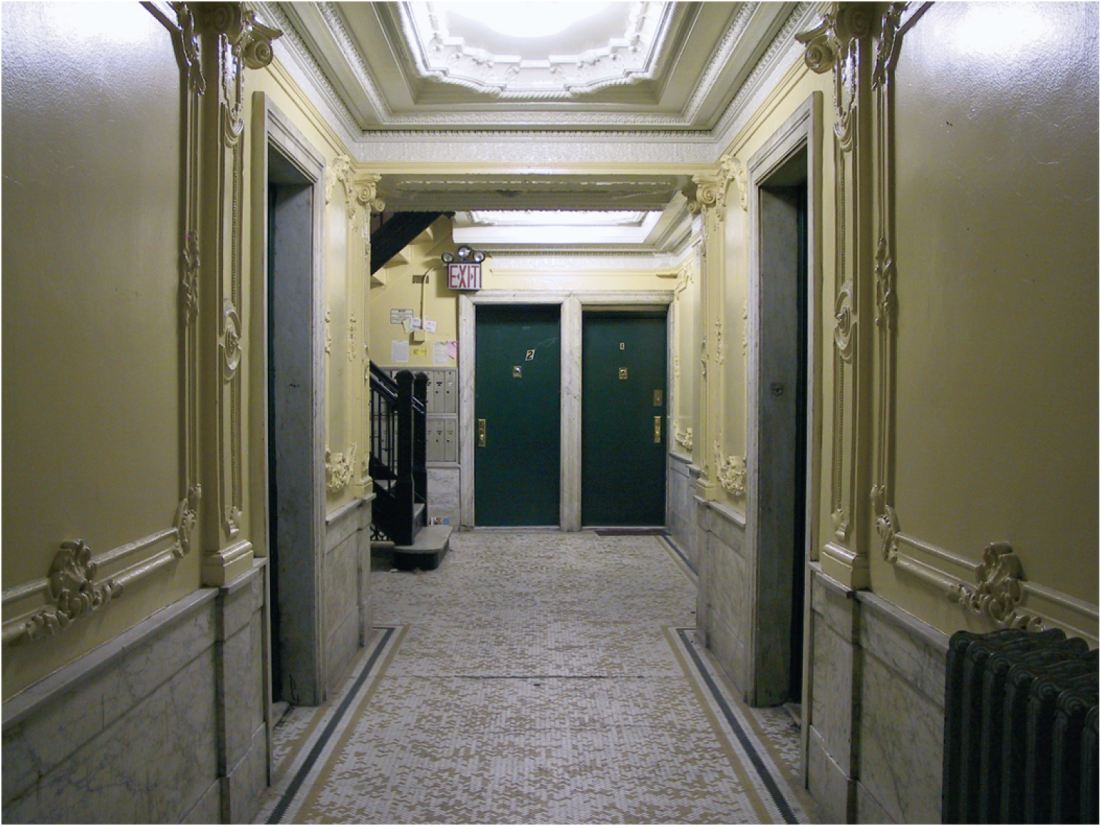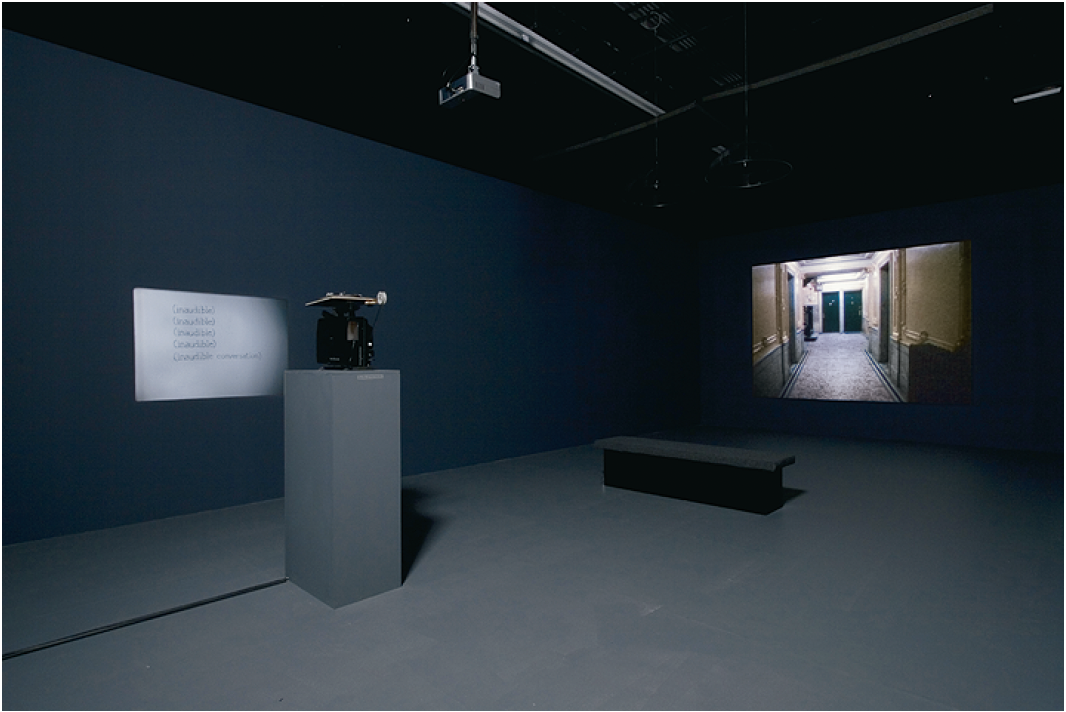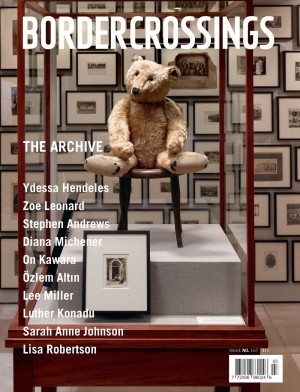Jenny Perlin
“ … what they can’t see, they learn….” These are words spoken in the privacy of a home from one friend to another, knowing that, although their presence and actions may not be witnessed first-hand, there are forces at play that will seek to know and constrain them. The words are those of Vivian Pataki, a woman who is aware that her fate may lie in the structures of surveillance. Access of information, investigations into systems of power and the tension between the seen and unseen are the issues Brooklyn-based artist Jenny Perlin explores in her film and video project, “Transcript.” The exhibition is based on the extensive FBI archive related to the infamous case of Julius and Ethel Rosenberg, American citizens who were executed in 1953 for allegedly conducting espionage for the USSR. Following their deaths, the FBI continued to spy on hundreds of people connected with the Rosenbergs, and it is at the periphery of this official history that Perlin’s work begins. She draws upon the information documented by FBI informants NY 963-S and NY 964-S at a dinner party held by Max and Annette Finestone on the evening of October 30, 1953—one small segment of the Rosenberg case, of American history and of the cold war. Through the projected images presented at The Kitchen, a New York contemporary art centre, the artist has provided an opening that offers a way out of the overwhelming archive of history that precedes each of us at every moment. It is Perlin’s ability to select, contextualize and reframe history through the discontinuous construction of time, via the collage forms of film and video, that enables us to trace connections between the era of the cold war and its contemporary echoes in the Patriot Act.

Jenny Perlin, Transcript, 2006, 16 mm film transferred to DVD, colour, sound, 11:25 minutes. Courtesy The Kitchen, New York.
Perlin’s exhibition is composed of two separate works: Inaudible, 2006 (16 mm, black and white, silent, 4 minutes), and Transcript, 2006 (16 mm transferred to DVD, colour, sound, 11:25 minutes). The first work, Inaudible, serves as the entrance and exit to the installation and, through the associative relationship of language, establishes the connections between the circumstances of the cold war and the current climate of counterterrorism. A stop-motion animation of continually unfolding text presents a series of words included in the transcript of October 30, 1953, but which were not discernable to the informants. These words, which had been underlined and bracketed, have been pulled by Perlin, in sequence, and presented in groupings of five. The discontinuous intervention establishes a new narrative and logic: him (hide it), Army, Torture (pressure), Worked (were), (inaudible response).
Reflecting the compact information of the contemporary sound bite, this example from Inaudible establishes a connection to the war in Iraq, Abu Ghraib, Guantanamo Bay and the surveillance now shrouding America through the Patriot Act. As the loop progresses, the animated text becomes distorted and threatens to fade into oblivion as it is diffused into the white light of the projector. Having faced the borders of the historical archive, Perlin’s new narrative holds to the limits of the materials used to record history and, in doing so, foregrounds the fragility of her project as document.

Jenny Perlin, Transcript, installation view, 2006. Photograph: Eileen Costa.
The second work, Transcript, echoes the structure of the archival format, but here Perlin has taken the disembodied text of the document and reconstructed it aurally through the use of actors reading the conversation of the individuals recorded by the informants. The past and the present merge as the artist layers the audio of the reconstructed transcript over a series of new static photographs of a New York City apartment building. Fleeting and distorted, like the textual information presented in Inaudible, the actors’ voices rise and fall in and out of comprehensibility, yet remain disembodied. The ominous interior views of the building mirror the imagery of the outsider looking in: empty hallways, bare stairwells leading nowhere and the anonymity of closed doors. The establishment of each new shot builds anxiety, providing no further visual information about the source or context of the conversation. Transcript does not loop cleanly, but stops the subjects mid-sentence. It is the film flares signalling the end of the roll that abruptly marks the video’s endpoint. Here, the edges of the document and its construction are revealed. With her video, Perlin has formed a collage that is far from the seamless conventions of narrative cinema, showing itself, and the record upon which it is based, as restricted and incomplete.
Jenny Perlin has reconstructed a moment largely unseen in the narrative of American history. In doing so, she has produced a transcript of her own: a new document that is no longer a product of the past, but loops endlessly in the present and will carry into the future, as the ongoing archive from the Patriot Act continues to amass. She uses cinema to form a counter-narrative, producing two systems of information—fluid loops in contrast to fixed history. Her project is remarkable not for the archival information it presents, which remains mostly concealed, but for the way it forges links between the past and the present through the assemblage of moving images. It leaves us with an opening, and responsibility, as viewers, so that what we cannot see, perhaps we will take it upon ourselves to learn. ■
Jenny Perlin’s “Transcript” was exhibited at The Kitchen in New York from December 15, 2006, to February 10, 2007.
Jacob Korczynski is an independent curator based in Toronto, where he is a member of the Pleasure Dome programming collective.

